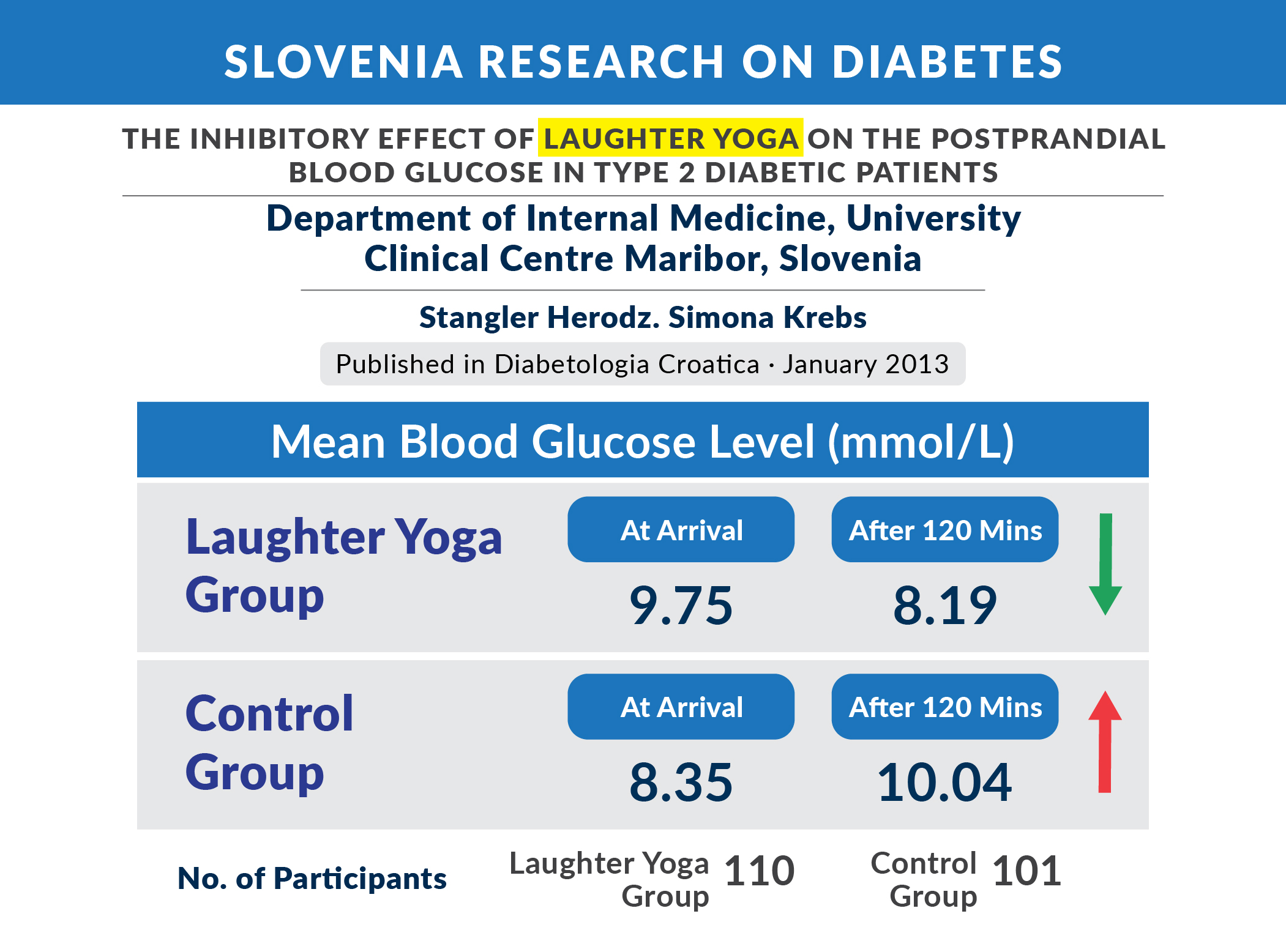
THE INHIBITORY EFFECT OF LAUGHTER YOGA ON THE INCREASE IN POSTPRANDIAL BLOOD GLUCOSE IN TYPE 2 DIABETIC PATIENTS.( Make lower case) - Slovenia Study
Čokolič, M.; Herodež, Š. Stangler; Sternad, S.; Krebs, S.
Journal: Diabetologia Croatica . 2013, Vol. 42 Issue 2, p54-58. 5p.
Link: https://www.academia.edu/23355773/The_inhibitory_effect_of_laughter_yoga_on_the_increase_in_postprandial_blood_glucose_in_type_2_diabetic_patients
Abstract: The aim of the present study was to determine the impact of Laughter Yoga on the blood glucose level in type 2 diabetic patients. For this purpose, we used laughter yoga, which includes respiratory laughing and fun exercises. The study involved 211 participants, of which 110 were involved and 101 were not involved (control group) in laughter yoga.
In both groups, the level of blood glucose was measured at arrival after they had standard brunch, a total of 250 Kcal. A 90- minute lecture was followed by 30-minute intense workout for those participants who had laughter yoga included in the program. In both groups, the level of blood glucose was measured after 120 minutes. We found the inhibitory effect of laughter on the increase in postprandial blood glucose (P<0.05). Our study indicated the importance of daily opportunities for laughter in patients with diabetes.
Know More About Diabetes
Diabetes is the most rampant disease in the world today, with more than 500 million people affected by it. It is a serious condition and a major cause of kidney failure, heart attacks, blindness, stroke, limb amputations, dental problems and nerve disorders.
A chronic disease, it occurs when there is an imbalance of sugar level in the blood. This is regulated by the pancreas which produces a hormone called insulin, which helps to regulate the blood sugar. But sometimes, the body is unable to produce insulin or it is not enough which leads to a diabetic condition, as glucose then remains in the blood and over time too much of it becomes a health hazard. Although there is no cure for diabetes, the condition can be effectively reversed with healthy food habits and lifestyle.
Different types of diabetes: The most common types of diabetes are type 1, type 2, and gestational diabetes.
Type 1 diabetes
Type 1 diabetes is characterized by symptoms like excessive excretion of urine, thirst, constant hunger, vision changes, fatigue and weight loss. It is usually common in children and young adults, although it can appear at any age. In this type, the body does not produce insulin at all and people with type 1 diabetes need to take insulin every day.
Type 2 diabetes
Type 2 diabetes is the most common, when the body does not make or use insulin well. One can get this type at any age but it mostly affects middle-aged and older people. One is more likely to develop type 2 diabetes if they have a family history or if they are overweight. Physical inactivity, genetic reasons and certain health problems such as high blood pressure also affect your chance of developing type 2 diabetes.
Gestational diabetes
Gestational diabetes usually develops during pregnancy and goes away after birth. However, if one has had gestational diabetes, they are at a greater risk of developing type 2 diabetes later in life.
Prevention of diabetes
Just a few lifestyle changes have proved to be very effective in preventing or delaying the onset of type 2 diabetes. All one needs to do is to live a disciplined life and do the following:
Achieve and sustain a healthy body weight
- Be more physically active: Walk for 30 minutes and do moderate-intensity exercises
- Eat a healthy diet and avoid sugar, saturated fats and tobacco
Diagnosis and treatment
Early diagnosis through an inexpensive blood test can help prevent type 2 diabetes and its complications. The treatment, besides the lifestyle changes and controlled diet, includes oral medication and insulin injections in advance cases.
Global organizations like WHO has launched an initiative (Global Diabetes Compact) to reduce the risk of diabetes and ensure that all people who are diagnosed with diabetes have access to equitable, comprehensive, affordable and quality treatment and care.

